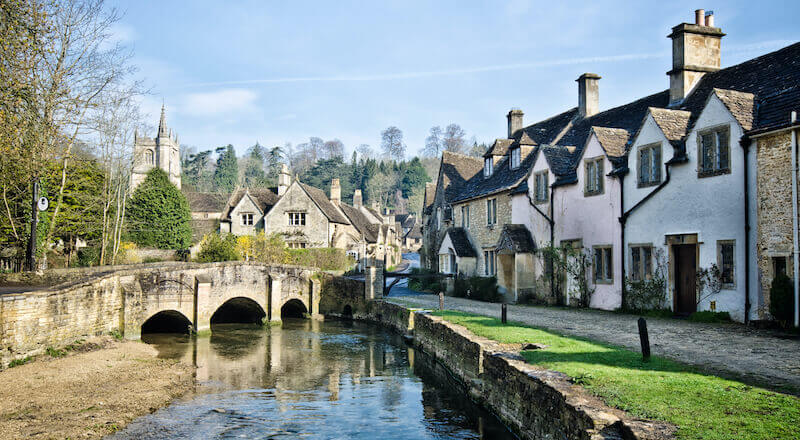Rural broadband: Options, availability and providers
 Dan Howdle • October 16th, 2024
Dan Howdle • October 16th, 2024

Living in the countryside is bliss for many, but if you live very remotely there are drawbacks that come with the territory, including the fact that, unfortunately, your broadband speed is likely to be poor.
Whether you're thinking of moving to the countryside, or already live rurally and have slow broadband, in this guide we will tell you what your options are for getting a good broadband connection, and explain why countryside broadband is often so much slower than it is for those living in towns and cities.
Why is rural broadband often slow?
To be fair, the situation has got a lot better in recent years, with most village locations in the UK having access to Standard Fibre, and some even lucky enough to get Full Fibre to most dwellings. However, those living in smaller villages, hamlets or completely isolated properties may still be suffering with speed issues that can be hard to solve.
The reason for this is that unless you're on Full Fibre, broadband slows down the further you are from the nearest cabinet or exchange. Hamlets and isolated residences, or small villages sprawling over a wide area are likely to be further from the nearest cabinet or exchange than any houses in a town or city, and thus only capable of receiving very, very slow broadband even though advertised speeds may indicate better speeds are available.
There are three main technologies that can suffer slower speeds when it comes to rural broadband, as well as others that can provide better alternatives, which we will cover further down. Here are the primary technologies most of us use and why they might be slow where you live.
Types of broadband available in rural locations
We will cover the best internet for rural areas in greater detail, each in its own section further down the page. First, though, here’s a quick overview of the best options for broadband if you live in the countryside in the UK that might or might not be available to you so you can get a handle on all the options.
- ADSL broadband – Sometimes referred to as 'standard broadband', it's delivered entirely over copper telephone wires and averages 10-11Mbps in locations where there aren't any significant issues. In remote locations, this speed can be a lot slower. Very few locations in the UK can now only get ADSL
- Standard Fibre Broadband – Is where the signal from the exchange to your nearest street cabinet arrives via a high-speed fibre optic cable, but where the remainder – the span between the cabinet and your home, often referred to as the 'last mile' – is covered by a copper telephone wire. For this reason, if you're suffering very slow ADSL speeds, a fibre connection may not help very much as it also has to cover this same final distance
- 4G/5G mobile broadband – Is internet access via a mobile network through any device containing a SIM. This can be your mobile phone, a dedicated mobile broadband home router, a dongle you can plug into your PC, a Mi-Fi hotspot and more. We will detail these further down. 4G and 5G broadband remains one of the best broadband solutions for rural areas
- Satellite broadband – This is broadband transmitted to your home via a satellite dish attached to your home. There are some significant drawbacks to satellite broadband which we will detail in its own section a bit further down, but if you cannot get anything else it's still the best internet for remote areas
- Fixed wireless broadband – This is broadband received via a wireless, line-of-sight transmitter installed somewhere high up and central (often on a church spire) in a rural area. This emitter relays a signal to another device mounted facing towards it on the side or top of your home. Obviously, this is not something you can choose to get as an individual – the infrastructure must already be in place for the whole community
- Bonded broadband – This is where you pay for two or more lines to be connected to your home, which multiplies the speed of the incoming signal. It is very expensive and primarily aimed at businesses. Also, you will need to find a specialist provider, and if the best you can get is 2Mbps, say, one might argue that 4Mbps at large cost to the householder isn't going to make as much difference as some of the alternatives
- Community broadband (FTTP) – This is where your local community has banded together to dig their own trenches and install their own broadband network. B4RN (Broadband for the Rural North) is just one example of this. If there is something like this where you live, chances are you already know about it
- Local altnets – Virgin Media and Openreach are not the only networks in the UK – there is an increasing number of local alternative networks (altnets) being built across the country, focussing on areas that cannot otherwise access high broadband speeds
Rural fibre broadband
If you're on ADSL and it's very slow where you live and you are considering upgrading to fibre, be warned – if you're suffering much slower speeds than those advertised already, fibre may not solve your problems. Just check with your provider and it will be able to tell you the speeds you can expect if you upgrade to fibre.

It's worth noting, too, that not all providers offer the same speed to your specific household. Some have their own equipment installed at the exchange and in the nearest cabinet, and this can affect the speed you get, even on very slow lines. Don't expect miracles, though. Virgin Media is the only national operator not on Openreach (if you can get Virgin Media, your worries are over as it is very, very fast no matter where you are).
Most other operators are on the Openreach network, so while speeds may vary a little, they won't vary a lot. If you're switching broadband or getting a new connection in a new home, your new provider will have to give you a speed estimate for your line during sign-up. When they do, you can then look around to see if that is the fastest service on offer. You can use our rural postcode checker to see what else is available.
Mobile broadband for rural locations
Whichever of the following types of mobile broadband you think might work as a viable alternative to a fixed-line internet connection, they all share one thing in common: they all arrive via a mobile network and a SIM card, with the primary difference being the device it arrives at and what sort of need that serves.
- Mi-Fi devices – These can also be USB devices, but will often only use USB to charge their batteries. Mi-Fi devices are small, pocket-sized boxes that act exactly like a home broadband router, with the obvious difference that they are battery-powered and you can take them anywhere. You won't get the same sort of range on one of these that you will on a home router, but they are a good way for lots of people to access the internet if they are all sat relatively close to it
- 4G/5G home broadband – Only a few providers offer this (for example Three Broadband), but this is essentially the same as a Mi-Fi device, only this one plugs into the mains and is designed to act as your full-time home broadband router. As with Mi-Fi, it won't need a fixed line, but instead uses mobile network data. Many providers now offer unlimited data too, making it an ideal alternative to a cabled broadband connection
- Dongles – Usually come in the form of a USB 'stick' that looks a lot like those USB memory sticks you also barely see anymore. A dongle plugs into a single device – usually a laptop – and uses a mobile network to provide internet access to that device only. They're hard to come by these days, but one or two providers do still offer them
- Data only SIMs – The most common use for these is to put one in a tablet. They provide mobile data only, without a phone number, or a calls and texts bundle. Quite a lot of newer laptops and tablets have a SIM slot for one of these. So, if your laptop can accept one, you could have internet access wherever you go without the need for a dongle, subject to signing up for a SIM-only data deal
- Mobile hotspots/tethering – If you have a smartphone, chances are you can do something called 'tethering'. This is where you go into your Wi-Fi and connectivity options and switch on your 'mobile hotspot'. This essentially temporarily turns your phone into a mobile broadband router. If you can do this reliably, it can be ideal as an additional means to get other devices online. Just bear in mind it will eat up a lot of data (and battery power), and the range is terrible compared to a proper home router
Satellite broadband for rural homes
The good news about satellite broadband is anyone can get it, and you can get speeds ranging from 30Mbps up to 220Mbps. And while it remains the best option for broadband access in completely cut off rural locations, there are some significant downsides. Primarily expense, but others too. They are:
Comparatively very expensive – Both for installation and monthly cost, satellite broadband deals are significantly more expensive than comparable fixed-line broadband connections.
Slower than fibre – Although 220Mbps is the top speed, the average of 30-50Mbps is many times slower than a Full Fibre package from the likes of BT, EE or Vodafone. You need a dish on your home – This may not bother many people, but if you have a particularly picturesque home, you may not want a dish installed on it.
Usually limited – Satellite broadband deals will usually limit you to a certain amount of data per month, which most people will find very restrictive. Even Starlink, once unlimited, is now limited, and while its 40GB per month isn't that unreasonably priced, packages go up to 6TB, and with an absolutely eye-watering price tag.
High latency – While this isn’t a problem for anything that doesn't require an instant response from the server, such as streaming movies or browsing the internet, the latency (or delay) caused by the signal having to go to space and back means you will struggle to play Call Of Duty or other fast reaction-focused online games, and you'll experience noticeable delay in videa and voice calls.
Fixed wireless, bonded, and community broadband
We've bundled these together because the chances are you either cannot get them or cannot afford them. Both fixed wireless and community broadband projects require buy-in from the entire community. Bonded lines, on the other hand, are prohibitively expensive and do not offer substantial gains.
